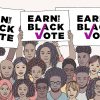Eric Herschthal
On the face of it, what happened in the tiny island of Barbados 400 years ago seems irrelevant to Americans today. Even now, the island matters to Americans for perhaps one reason: the weather—it’s a popular tourist getaway. But in her exceptional new book, Sugar in the Blood: A Family’s Story of Slavery and Empire, Andrea Stuart insists Barbados, with its long history of slavery, matters more than we know.
“I wanted to take slavery out of its niche,” she said. “It’s not a black story, it’s not a white story. I want to remind people that this story belongs to us all.” Slavery and its legacy—race—still shape our world. But more specifically, the creation of Barbados, the British empire’s earliest, most profitable settlement in the New World, provided the blueprint for all its future slave colonies: South Carolina, North Carolina, Virginia, Georgia, you name it.
The island’s first settlers, like Stuart’s white ancestor George Ashby, arrived in the early 1600s. Spain was raking in huge profits with their New World colonies, mainly by extracting gold and silver. The British wanted to catch up, but when they arrived in the Caribbean, no precious metals were found. Within a few decades, however, they discovered they could make money by cultivating another precious commodity: sugar, or as it was called by many at the time, “white gold.”
That demanded workers, and the British quickly found a cheap labor source: African slaves. By century’s end, 80 percent of Barbados’s 85,000 inhabitants were Africans, giving rise to a rigid racial hierarchy: a small elite of whites on top; the masses of black workers on bottom; and, somewhere in between, a small caste of illegitimate mixed-race children, born to masters and their preyed-upon female slaves.
Given how small the island was, many of the whites who couldn’t establish a large plantation moved on to other British colonies. Many went to places that would become part of the United States. They replicated the Barbadian plantation model, growing mainly rice and tobacco, and had an outsized impact on early America. In colonies like South Carolina, six of the governors were Barbadians between 1670 and 1730. Other Barbadian émigrés, like George Ashby’s Quaker brother, helped settle Pennsylvania. Barbados was so important to the British colonial system that even George Washington, who only left North America once in his life, made that stop on the island, to help his sick brother recover from an illness.
Famous names are dropped throughout Stuart’s narrative, but she decided to weave her narrative around the unknown millions who made the island thrive. “It’s a challenge with normal people in history, and what to do with them,” she said. “They leave so little trace in history, the small people, but they’re just as touched by history as kings and queens.
The “small people” she chose to focus on are her own descendants: George Ashby; his descendants like the wealthy plantation owner Robert Cooper; and several of Cooper’s slave concubines and their black children. Stuart’s mixed racial heritage helped her paint such a ruthlessly honest portrait of slavery, where she can both admire and revile slave-owners like Cooper—even wonder whether some of the slaves he slept with may have loved him.
“The reality is that most blacks have mixed blood,” she said. “When I was doing research on George Ashby, I felt some empathy. There’s something brave about leaving the world you know. If you can make that empathetic journey, you can show a more complicated picture.”
One of the book’s strengths is its depiction of the social dynamics slavery created. Not all blacks were treated the same, and ones with white blood often had a leg up. Cooper gave an education to his illegitimate slave child John Stephen; he taught him a craft that enabled him to support himself after Britain emancipated all its slaves in 1833, and he was the first slave descendant Stuart was able to find records for. But she never loses sight of the overwhelming barbarity that made slavery one of history’s greatest crimes. “On a day-to-day basis,” she writes, slavery “was sustained by a campaign of violence and brutality, random whippings, mutilation and branding, mobilized to remind the slave who he was.” Slaves like John Stephen never found out who their mothers were. Stephen did know who his father was, though Cooper owned him, and Stephen had to call him “Massa.” Slavery’s racial legacy affects Stuart’s life to this day, like it does most blacks: “My color still enters the room before I do,” she writes. “And in some situations I have to work inordinately hard to make others put it aside.”
In her discussion of why Europeans went to Africa to get slaves, for instance, she places too much emphasis on economics. “In the end,” she writes, “the introduction of slavery was driven largely by economics.” She says that African slaves were cheaper than European indentured servants, which were the main labor force British colonists used before the introduction of slavery. But that is only partially true. As the historian David Eltis has argued, the British could have used their own lower classes as slaves, which would have been cheaper than going to Africa. Other ideological factors might have been in play. Stuart discusses the emergence of European racial thinking, but only as a consequence of slavery, not as something that might have been less fully formed—but still at work—in their decision to enslave Africans in the first place.
If economics were so central to the rise of the African slave trade, it would have made little sense for the British to abolish the trade in 1807, a time when their plantation system was reaping enormous profits. As the historian Seymour Drescher memorably put it, the British were committing “econocide” by ending the trade when they did. African leaders also contributed to slavery’s rise in the New World, readily selling slaves they had captured from other tribes. Stuart has virtually no discussion of their role, an omission that she regretted, she told me.
The oversight is unfortunate in Stuart’s otherwise invaluable approach of demystifying history, turning our attention away from kings and queens and reifying abstract forces like slavery and empire. But sometimes Stuart also goes too far in the opposite direction, and the tale becomes too personal. Two-thirds of Sugar in the Blood consists of an impressively researched history of Barbados up until the last century. But instead of finishing the task, Stuart essentially gives us a memoir in the third act. We hear news about the people she knew personally—grandparents, cousins, her mother, her father—but without a full sense of how they fit into the larger picture of the Caribbean’s recent past.
But some of those family stories are inspiring. Her father, for instance, became dean of the British Caribbean’s most prestigious medical school. Her mother, a descendant of Ashby, helped manage a sugar plantation her family inherited, bringing the story full circle. Stuart’s parents made sure education became her own avenue to success, which led her to the renowned English program at the University of East Anglia, and she later attended the Sorbonne. Stuart readily concedes that, despite her own hard work, her privileged background has given her a chance to partially overcome the racial legacies that still oppress so many other black lives.
In fact, Sugar in the Blood perfectly shows how slavery is relevant to everyone in America—black, white, and brown. “[There’s] an obligation to engage with this history, especially since slavery wipes out history, quite deliberately,” she said. “I’ve always been interested in the epic story of how sugar, slavery and settlement shaped individual lives. I just had to find a way to tell it.”














